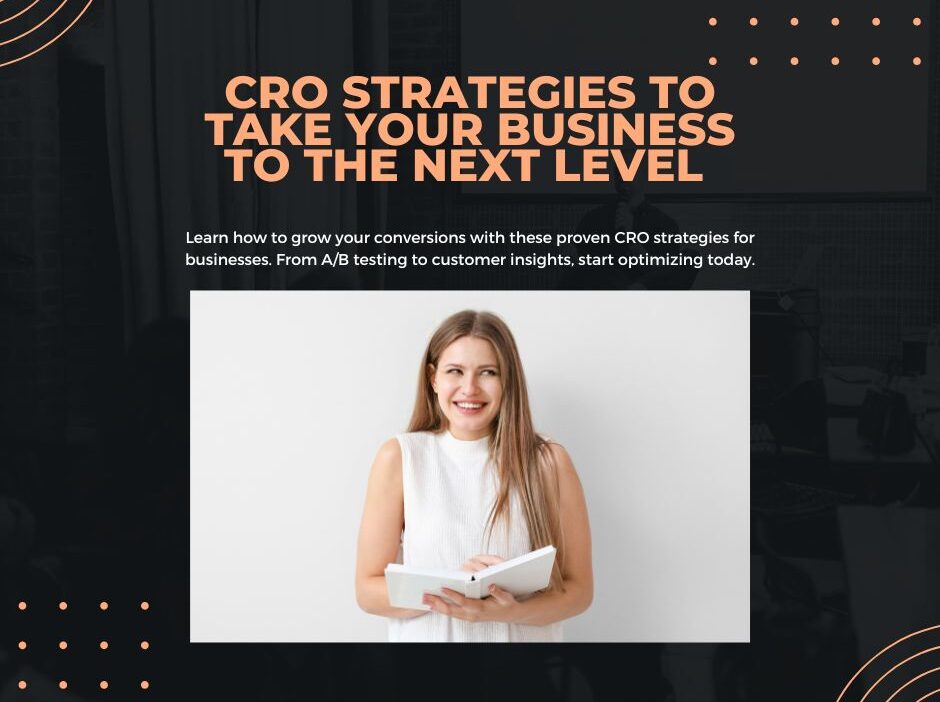When it comes to digital marketing success, concentrating only on driving people to your website is insufficient. So what is the plan after these visitors arrive? That’s where Conversion Rate Optimization (CRO) strategies enter in. CRO strategies are the digital marketer’s ace in the hole to make sure all that valuable traffic converted into measurable results do not simply pass by, whether that means sales, leads, sign-ups or any other sort of core performance goals.
What Is Conversion Rate Optimization?
Before diving into strategies, it’s essential to understand CRO itself. Conversion Rate Optimization is the process of enhancing the user experience on your website to encourage visitors to complete specific actions. These actions, otherwise known as “conversions,” could range from purchasing a product to downloading a white paper, signing up for a newsletter, or even simply clicking a button.
Mathematically, the conversion rate is calculated as follows:
Conversion Rate = (Conversions / Total Visitors) x 100
For example, if 1,000 visitors land on your website and 50 of them make a purchase, your conversion rate is 5%.
CRO focuses on improving this percentage, ensuring every visitor action aligns with your business goals.
Why CRO Is a Game Changer for Your Business
- Maximizes ROI
CRO ensures that you’re making the most out of your current traffic before spending more money on ads or other acquisition efforts. For businesses, it’s a cost-effective way to increase revenue.
- Enhances User Experience
By optimizing for conversions, you inherently create a smoother, more engaging experience for your audience. A win for your visitors often translates to a win for your business.
- Boosts Competitive Advantage
A website optimized for conversions stays ahead of competitors by capitalizing on every visitor. It’s like squeezing every bit of juice out of a lemon.
- Provides Actionable Data
Beyond improving conversions, CRO also uncovers invaluable data about your audience’s behaviors, preferences, and pain points.
Now that you know why CRO is essential, let’s look at key strategies to improve your website’s performance.
Proven CRO Strategies To Boost Your Website’s Conversions
1. Understand Your Audience and Their Journey
A successful CRO strategy starts by knowing your audience inside and out. Why are they on your site? What are they looking for? Where might they drop off?
Steps to Understand Your Audience:
- Leverage Analytics Tools:
Tools like Google Analytics or Hotjar give valuable insights into user behavior, such as bounce rates and heatmaps.
- Customer Personas:
Develop detailed profiles of your target audience, including their pain points, motivations, and goals.
- Surveys and Feedback:
Use on-site surveys or post-purchase emails to collect input directly from users about their experience.
2. Conduct A/B Testing
One of the most effective tactics in CRO is A/B testing (or split testing). This involves presenting two versions of a webpage to different segments of users to see which performs better.
What to A/B Test:
- Headlines or hero text
- Call-to-action (CTA) button colors or placement
- Product images versus lifestyle images
- Form lengths
For instance, imagine you’re testing a headline on your landing page. One version says “Get Your Dream Body Today,” while another says “Start Your Fitness Journey.” Testing these variations can show which resonates better with your audience.
3. Optimize for Mobile Devices
With over 50% of traffic coming from mobile devices, optimizing your site for mobile users is non-negotiable. Mobile users demand fast-loading pages, simple navigation, and easy access to information.
Mobile CRO Tips:
- Ensure pages load in 3 seconds or less.
- Use thumb-friendly navigation.
- Avoid pop-ups that are difficult to close on smaller screens.
4. Create Clear and Compelling CTAs
Your visitors should know exactly what action you want them to take. A compelling, visually prominent call-to-action (CTA) can significantly improve your conversion rates.
Tips for Effective CTAs:
- Use action-driven language (e.g., “Shop Now,” “Download Free Guide”).
- Make your CTA buttons stand out with contrasting colors.
- Place CTAs strategically above the fold and at key decision points.
5. Leverage Social Proof
People tend to trust a product or service that is endorsed by others. Social proof creates credibility and builds trust, nudging visitors toward conversion.
Forms of Social Proof:
- Customer reviews and testimonials
- Trust badges and certifications
- Case studies and user-generated content
- Displaying the number of users/customers
For example, showing “Trusted by 50,000 happy customers” can boost credibility significantly.
6. Simplify Navigation and Reduce Friction
A confusing or slow website is a surefire way to lose potential customers. Streamlining navigation and simplifying your design can guide users toward conversion without unnecessary roadblocks.
How to Reduce Friction:
- Declutter Pages:
Avoid overwhelming users with excessive text or images.
- Limit Form Fields:
Ask only for essential information to sign up or check out.
- Provide Clear Pathways:
Use breadcrumbs and intuitive menu structures.
7. Use Retargeting Strategies
Sometimes, visitors don’t convert on the first visit—but that doesn’t mean the opportunity is lost. Retargeting ads help bring back potential customers who have shown interest in your offerings.
Effective Retargeting Tactics:
- Use dynamic ads to showcase products a user previously browsed.
- Offer discounts or limited-time promotions to encourage return visits.
8. Utilize Tasting Content and Engaging Storytelling
Content marketing is an essential component of CRO. Providing free, high-value content can help you build credibility while guiding your audience through their decision-making process.
Examples:
- Blog posts that address a common problem your audience faces.
- Interactive quizzes or product recommendation tools.
- Videos highlighting your brand story or customer experiences.
9. Don’t Ignore Website Speed
Site speed directly affects bounce rates and, consequently, conversion rates. Studies show that even a one-second delay in load time can diminish conversions by as much as 7%.
Speed Optimization Tips:
- Compress images.
- Enable browser caching.
- Use a Content Delivery Network (CDN) for faster load times globally.
10. Continuously Monitor and Adjust
CRO is not a “set it and forget it” process. You need to continuously monitor your metrics, test new ideas, and adapt to your audience’s changing preferences.
Key Metrics to Watch:
- Conversion rates
- Average session duration
- Exit rates
- User flow through your site’s most important pages
Take Action to Achieve Your CRO Goals
Conversion Rate Optimization is not just something you do; it’s how you think. By putting visitors first, listening to data, and utilizing the strategies described above, you can expect significant makeovers in both website performance and business profitability.
Looking to get started on CRO but need some guidance? Try browsing our expert resources, and see how we can help you optimize those conversions. It could be that your website will run much more effectively and earn more with just one small change.





